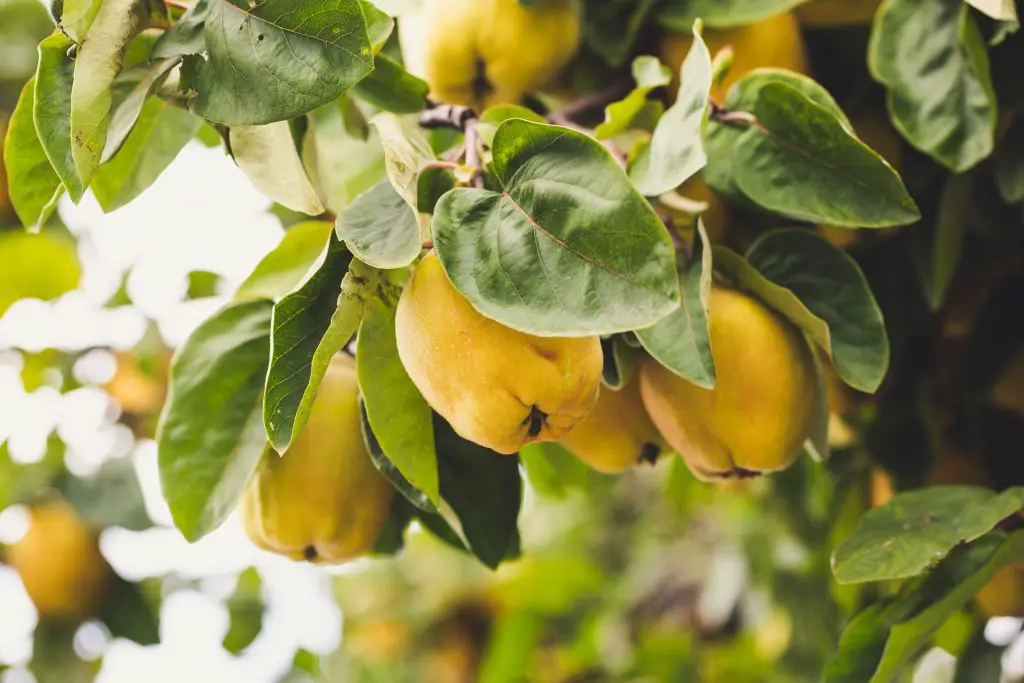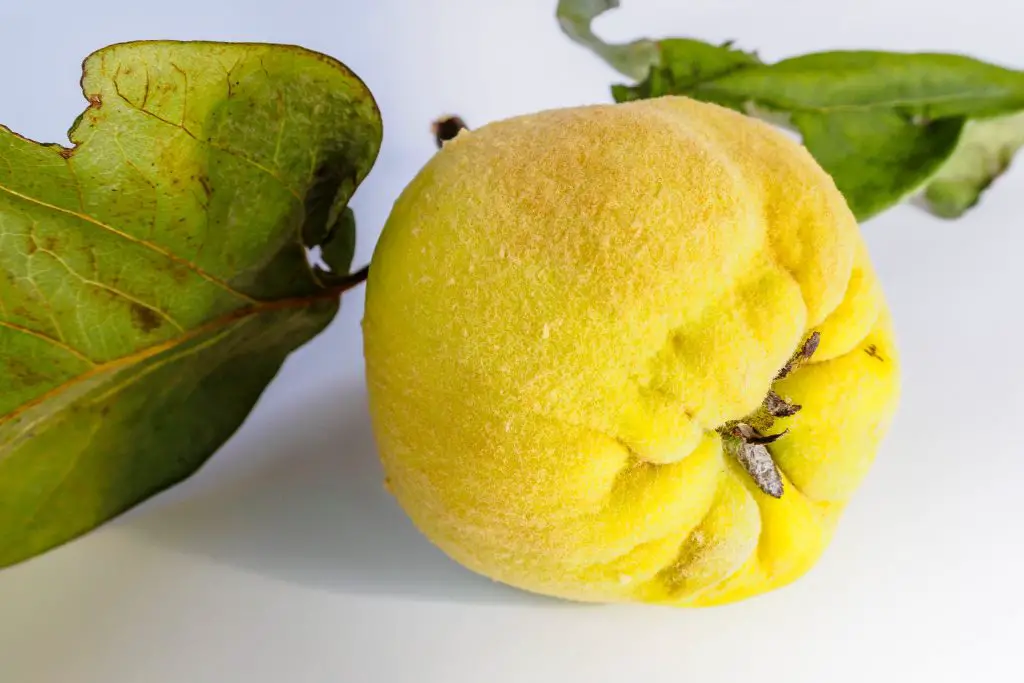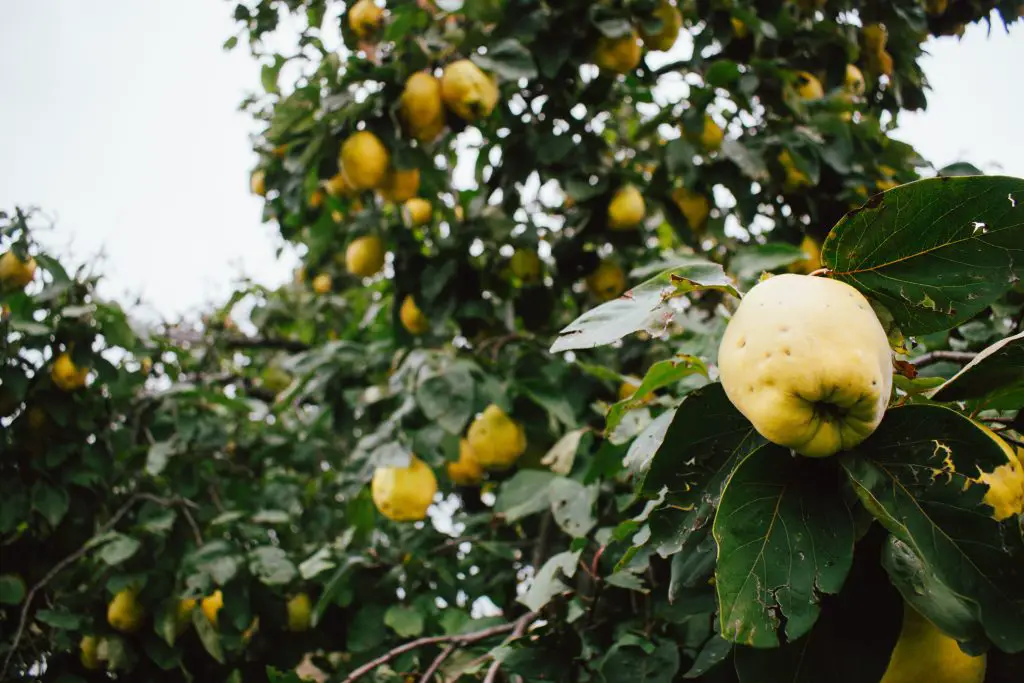How Much Does Quince Tree Produce? Quince trees were once an extremely popular fruit tree in the 17th century when cooking of fruit was common, but, as the cooking of fruit has declined so has the popularity of the Quince tree, due to the need to cook the fruit before eating it. However, the Quince is a highly ornamental tree and is highly productive and as is worth considering for your garden.
A mature Quince tree will yield on average around 110 lbs (50 kg) of fruit per year according to the study by the University of Belgrade. Most varieties of fruit trees will take around 2 to 3 years to produce their first crop and it will take around 10 years for a Quince tree to reach full maturity.
There are a little over 100 different varieties of Quince that exist worldwide which produce fruit that varies in size and shape. Some varieties resemble a pear-like shape while others are more rounded or oblong in shape. In most cases, the fruit produced is larger than common pear varieties.
Of the varieties tested in the University of Belgrade study, the best performed in terms of yield were ‘Triumph’ and ‘Portugal’ averaging, over a four period, 148.6 lbs (67.4 kg) and 140 lbs (63.5 kg) respectively.
Triumph is a variety of Quince with pear-shaped fruits that weigh on average 4.9 oz (420 g). It has a smooth skin that is greenish-yellow, that is slightly fuzzy. It is a self-fertile variety but like many other fruiting plants will experience improved yield if planted in combination with a second variety such as Portugal.

Portugal is said to be one of the best flavored Quince varieties and also has a pear-shape, like Triumph, that is relatively long, yellow in color with grey fuzz covering the surface. The tree is more vigorous than other cultivars, but less hardy and is not able to tolerate severe winter weather conditions.
How To Grow A Quince Tree
Quince trees originated in Asia and are suitable for growing in zones 5 to 10 and as a general rule they enjoy conditions similar to Apples and Pears, though they are not as frost tolerant as Apples. However, like Apples and Pears, Quince trees require a period of cold in order to produce fruit.
The length of time required is typically 100 to 500 hours at less than 45°F (7°C), this measure is sometimes referred to as chill hours. To assess the suitability of your particular climate the number of chill hours can be approximated by taking the average temperature of the coldest month in your location and comparing it to the table below.
Chill Hours Average Temperature For Coldest Month
0 19.7°C (67.5°F) – No Chill
300 15.5°C (59.9°F) – Low Chill
330 15.3°C (59.5°F) – Low Chill
450 14.0°C (57.2°F) – Medium Chill
500 13.6°C (56.5°F) – Medium Chill
520 13.1°C (55.6°F) – Medium Chill
600 12.7°C (54.9°F) – Medium to High Chill
800 10.2°C (50.4°F) – High Chill
1100 7.9°C (46.2°F) – High Chill
1250 0.0°C (32.0°F) – Very High Chill
Preferred Conditions For Quince Trees
Assuming that your climate is suitable the next consideration is the location of the tree. Like most flowering plants Quinces do best in a sunny location that gets at least 8 hours of sun per day.
In terms of soils, Quince trees are generally tolerant of most soil conditions provided that there is sufficient moisture present. As a result of this requirement, heavier soils with greater moisture retention capacity are preferred over sandy soils. Mature trees can cope with relatively wet conditions for a period of time though being exposed to thoroughly saturated soil for a sustained period is far from ideal.
Additionally, it best to avoid sites that are exposed to strong winds particularly on North facing slopes (in the Northern hemisphere) as the cold winds in early spring can disrupt the pollination of flowers.
In terms of pH Quince trees generally prefer a soil that is slightly acidic, the main reason for this is that Quinces are particularly susceptible to iron deficiencies. The availability of Iron to the tree improves in acidic conditions.

How To Plant Quince Trees
Quince trees are best established when the tree is dormant in later winter, however, if you live in a location where the ground freezes the planting will need to be delayed to early Spring. At this time of year, Quince trees can be purchased as bare-rooted trees which are a relatively cheap way to buy the trees.
Once the tree has been selected it is important to prepare the soil well prior to planting. Generally, it is a good idea to add additional organic matter in the form of compost which should be dug in thoroughly before creating the planting hole.
The planting hole for the tree should be approximately 1 ft (30 cm) wide by 1 ft (30 cm) deep. Once complete the tree should be placed in the hole at the same height as the tree was previously in the ground. To ensure that excessive suckers are not produced by the tree it is important to ensure that the graft union is around 2 inches (5 cm) above the ground.
Once you are happy with the location of the tree the hole should then be backfilled with soil. At this stage, it is important to firm the soil around the base of the tree using your heel to ensure there are no air pockets around the root ball.
Create a well around the base of the tree and fill it with water a few times to ensure that the tree is thoroughly watered in. Then place a layer of mulch, 2 to 4 inches (5 to 10 cm) thick around the base of the tree ensuring that the mulch does not come into contact with the trunk of the tree. This will avoid any chance of collar rot occurring.
At this point the tree needs to be pruned, the ideal shape for fruit production is a vase-shaped tree as this maximizes light and air circulation which will aid in the ripening of fruit. To encourage the tree to form this shape start by removing any inward-facing branches. For the remaining branches cut them around 1 to 2 ft (30 to 60 cm) above where the branches fork, just above an outward-facing bud.

This cut, when carried out in winter, will result in the tree producing 2 to 3 new shoots in the following growing season. To maintain the desired vase shape the new inward-facing growth should be removed and the new growth should be trimmed again 1 to 2 ft (30 to 60 cm) above the newly created fork in the tree.
Caring For Young Quince Trees
Young Quince trees, which will have relatively limited root development, can be susceptible to drying out in warm weather. It is important, when long dry periods occur, that the trees are watered regularly to ensure that there is sufficient moisture available to meet the tree’s growth requirements.
Access to moisture can be improved by removing grass and weeds around the base of the trees. During this early period, it is likely that suckers on the tree may develop, they need to be removed as soon as they appear.
In the first few seasons, Quince trees are particularly susceptible to late frosts during the flowering period which has the potential to cause damage to blooms and reduce the yield of the trees. To reduce the chances of this occurring it is best to protect the tree using a frost blanket on nights where a frost has been forecast the following morning.
Frost blankets can are also useful in protecting the tree against excessive winds. Quinces are particularly susceptible to wind damage because the branches are relatively floppy, compared to Apples or Pears. This results in the fruit being blown around quite a bit which can cause damage.
Harvesting and Storing Quinces
Most varieties of Quince trees will ripen in early to mid-Autumn. When the fruit is ripe the color will change from green to yellow and the fruit begins to develop a pear-like aroma. Typically the first harvest can be expected when the tree reaches 2 to 3 years of age and they will continue to produce fruit for at least 30 years.
When removing fruit from the tree it is best to twist the fruit off the tree rather than pull them from the tree to avoid any chance of damage to the tree or the fruit.
Once the Quinces have been picked they will store for around 6 weeks to 2 months if stored in a cool dark location. To slow down the ripening process avoid storing them with ethylene-producing fruit such as bananas or Pears as this will accelerate the aging process.
